Roof tent guide: all you need to know
A roof tent can give you the freedom and flexibility to camp wherever you like at the fraction of the cost of a campervan. Here’s our comprehensive guide to everything you need to know
Page contents
- What are roof tents?
- Benefits of a roof tent
- Types of roof tent
- Alternative roof tents
- How to fit a roof tent
- Setting up a roof tent
- Driving with a roof tent fitted
- Our top roof tent picks
- Tips for using a roof tent
- Try before you buy?
- About our magazines
Words by Iain Duff, Editor of Camping magazine
What are roof tents?
Take a look around any campsite or festival and it’s impossible to ignore the number of cars fitted with roof tents.
Once the sole domain of off-road types, these days you’re just as likely to see a roof tent on top of a family car or a van as a 4x4.
A roof tent opens up a whole new world of adventure and their popularity is booming among couples and families.
And it’s not surprising. While a campervan might set you back £50,000 or more, for a fraction of that cost you can create what might just be the ultimate explorer’s dwelling. Adding a roof tent to your car is undeniably cool, and turns it into a mobile basecamp, giving you the freedom to go wherever you want and set up camp in minutes.
But what exactly is a roof tent? Well, unsurprisingly, it’s a tent that goes on the roof of your car or van. They generally mount on roof bars or a roof rack with brackets or clamps, and look like a roof box when packed away.
When you park up, the tent either folds or rises out of the ‘shell’, with a ladder that is then attached or extended down to allow you to climb up into the tent. In the morning, simply fold or remove the ladder and pack the tent away again until your next adventure.
Benefits of a roof tent
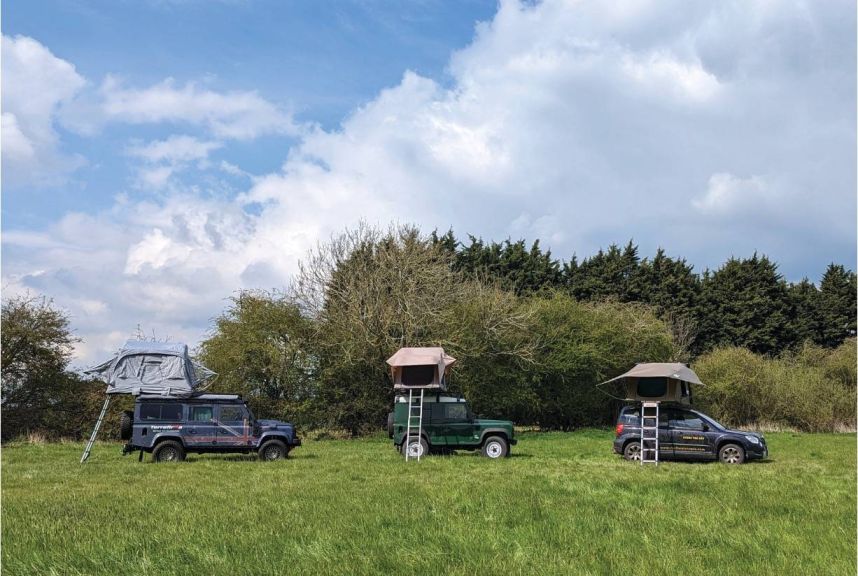
(Picture by Iain Duff )
Not only do roof tents offer a unique camping experience, but they also provide the convenience of being able to set up camp anywhere your vehicle can go. You don't need to worry about finding a dead level pitch or clearing away rocks and debris in the wild. Simply park your vehicle and pop open the tent. Some types can take a little bit longer than others to put up, but they are almost all quick and stress-free.
With minimal poles and in some cases just a couple of clips to release, roof tents really do make a lot of sense, especially if you often arrive at camp after dark and have more important things to worry about, such as getting the barbecue lit and cracking a drink open. It's the perfect shelter to prepare for – and recover from – a day hiking in the Lakes, wild swimming in Wales or surfing in Cornwall, for example.
With a cost of between £1,000 and £3,500, car roof tents have become increasingly popular among camping enthusiasts. Once the sole domain of hardcore explorers, these days all sorts of campers, from touring couples to adventurous families, are using them. If you need any evidence that they’ve hit the mainstream, consider the fact that even family camping specialist, Quechua, has developed its own models for sale in Decathlon stores, as has Go Outdoors.
Simon Towler, of retailer, Rooftent Utopia, believes the image of the typical roof tent user has changed in recent years.
The notion that if you have a roof tent you have to be a diamond miner in Namibia or something, is a thing of the past. They are for everyone to use now. You can use them on your local campsite, you can use them on the new pop-up campsites that are emerging, take them to festivals or even just on weekends away.
Simon added,
We’ve supplied them to people going off touring around Europe for several weeks, with anywhere from two to five people, on trips that can last months. Again, there’s a tent style that suits every type of travelling – there are some very quick-to-use ones and some that are a bit more involved in setting up and packing down but will give you a lot more accommodation.
Most roof tents come with the option of adding an awning or other zip-on living area, giving extra room for relaxing, eating and storing things like mucky boots. Having that accommodation stored on top of the roof means you instantly free up tonnes of space inside the car for more passengers and kit.
It also means that if the weather is inclement – not unheard of in the UK – you’re not having to bundle a soggy, muddy ground tent into your boot. Simply put the roof tent back up and let it dry out when the sun comes out.
Each type of car roof tent has its own advantages and disadvantages. Here, we’ll explore the different styles of roof tents, including electric, inflatable and fold-out models, and how they can be fitted to different vehicles.
Types of roof tent
There are two main types of roof tent: hard shell and soft shell. Hard shell tents are stored in a roof box made of durable materials such as fibreglass or aluminium and are designed to fold out easily into a sturdy, comfortable sleeping space.
Soft shell tents, on the other hand, are folded into a soft bag made of waterproof fabric and are typically lighter and easier to attach to your vehicle. Both types of tents have a base constructed from plywood or aluminium.
Both styles have their advantages, so it's important to choose the one that's right for you based on your camping needs and vehicle size.
Hard shell roof tents
Hard shell roof tents are becoming increasingly popular among campers, and for good reason. These tents are made with a sturdy outer shell that's designed to withstand harsh weather conditions and protect you from the elements. When not in use, the tent folds up into a compact unit that sits on top of your vehicle. When you're ready to set up camp, simply pop the tent open, add any poles or extensions, and climb inside.
One of the main benefits of a hard shell roof tent is its durability. These tents are typically made from high-quality materials that are built to last. The outer shell is usually constructed with a tough, weather-resistant material, while the inner tent is made from a breathable fabric such as canvas or polyester. The combination of these materials ensures that you stay dry and comfortable in any weather conditions. Hard shell roof tents also tend to be more aerodynamic than their soft counterparts, which can improve your vehicle's fuel efficiency. Additionally, many come with built-in features such as lights, storage pockets, and even solar panels.
Of course, there are some downsides to hard shell roof tents as well. For one, they tend to be more expensive than soft shells, and they can be heavier as well. Additionally, some models can be more difficult to set up and take down, especially if you're doing it alone – but the Femkes Alu Khosi is exceptionally easy.
Soft shell roof tents
Soft shell roof tents are the more traditional option, and have been a popular choice among campers for many years. These tents are made from a soft, flexible material such as canvas or nylon, and they fold up into a compact unit that sits on top of your vehicle. A weatherproof cover goes over the top to keep them dry. When you're ready to set up camp, simply remove the cover and quickly unfold the tent. With a bit of practice they can be set up in a couple of minutes, but even complete novices can have them ready in a few minutes.
One of the main benefits of a soft-shell roof tent is its affordability – the Front Runner Outfitters tent weighs in at just £1,129. These tents tend to be less expensive than the hard shell option, which makes them a great choice for campers on a budget. Additionally, soft shell tents are typically lighter and easier to set up than hard shell tents, which can be a major advantage if you're camping alone or with a small group.
Soft shell roof tents also tend to be more versatile than hard shell tents. Because they're made from a flexible material, they can often be used on a variety of different vehicles, including cars, vans, and Land Rovers. Additionally, many models come with built-in features such as mosquito nets and ventilation panels, which can help you stay comfortable and bug-free throughout the night.
Of course, there are some downsides to soft shell roof tents as well. For one, they tend to be less durable than hard shell tents, which means they may not hold up as well in harsh weather conditions. Additionally, they can be more difficult to pack up and store, as they require more space than hard shell tents. You’ll also have to think about where you will store the cover while you’re parked up.
Alternative roof tents
In recent years, new technical innovations have been introduced to the car roof tent market, designed to make them even easier to use. Although some people consider products such as electric and inflatable tents as gimmicks, there’s no doubt that they are popular and can make camping easier.
Inflatable roof tents
Inflatable roof tents – such as the Terrafirma – are another innovative addition to the roof tent market. They are made with durable materials that can withstand the elements and are inflated with a manual or electric pump. Inflatable roof tents are typically lighter in weight than traditional roof tents and can be set up and taken down quickly.
One of the main advantages of inflatable roof tents is their ease of use. They can be inflated in just a few minutes, which makes them perfect for those who are short on time or who want to avoid the hassle of manually setting up a traditional roof tent. However, they do require a bit of extra care to ensure they are not damaged during use.
Eddie Priscott, Director of Terrafirma, says,
An inflatable roof tent is a really good option for somebody who wants to have a more compact tent on the vehicle. It’s within the weight limit of most small SUVs and it’s ever so easy to put up – it’s more manageable because the sections are smaller.
Electric roof tents
Electric roof tents are a relatively new addition to the car roof tent market. They are fitted with an electric motor that allows for easy and quick set-up and take down at the flick of a button. This type of roof tent is perfect for those who want the convenience of a roof tent without the hassle of manually setting it up. Electric roof tents are typically made with hard-shell materials, which provides more protection from the elements and offers better insulation.
One thing to consider when choosing an electric roof tent is the power source. Most models require a 12V power source, which can be obtained from your vehicle's battery. However, this can drain your battery quickly if you are not careful.
How to fit a roof tent
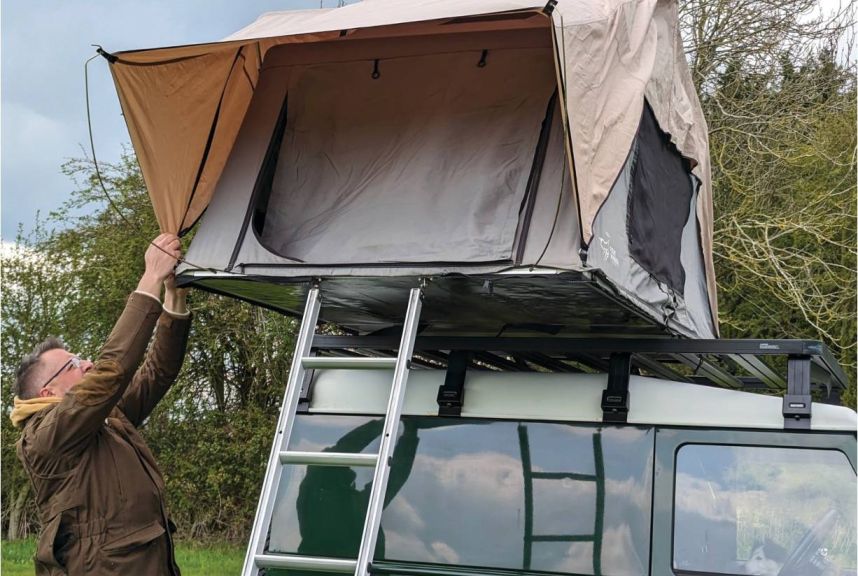
(Picture by Iain Duff )
So, can you put a roof tent on any car? Roof tents are available to fit almost any car, from hatchbacks to large 4x4s. The two main factors to consider are that you have a roof rack or roof bars fitted that are the correct distance apart to suit the tent model and that your car is capable of supporting the combined weight of the tent, its cover and the roof bars. Before you begin fitting a roof tent to your vehicle, it's important to make sure that your roof is strong enough to support the weight of the tent. The roof load capacity of your vehicle must be greater than the weight of the roof tent you’re thinking of putting on top. The weight of the roof tent will be provided by the manufacturer.
Check your vehicle's owner's manual for weight limits and recommended roof bar systems. It's also a good idea to consult with a professional if you're unsure about your vehicle's capacity. Remember the roof load limit is the maximum your vehicle can carry while it is being driven and it takes into account the potential effect on the vehicle’s handling and risk of rolling, as well as how much weight the roof can handle.
As the handling and roll risk are irrelevant when your vehicle is parked, it’s only the load capacity that matters. The static load is considerably higher than the dynamic load because the vehicle isn’t subject to the same pressures as it would be when on the road, so there’s no need to worry about the weight of people in your roof tent. They can easily accommodate two large adults sleeping inside. Assuming, of course, they only get inside when it’s not moving!
Once you've determined that your vehicle is capable of supporting a roof tent, you'll need to choose a roof bar system that's compatible with your vehicle and tent. Some manufacturers offer roof bars specifically designed for their tents, while others may require a universal system. Make sure to choose a rack system that's appropriate for the fixing system on your vehicle and for the weight of your tent and any additional gear you plan to bring along.
When installing the roof bar system, be sure to follow the manufacturer's instructions carefully. This will ensure that the system is properly installed and secure. Even better, get it fitted by an expert at a retailer like Halfords. Once the bars are in place, you can lift the box into place (you’ll need some assistance) and attach it to the rack using the manufacturer's recommended method. This may involve using straps, clamps, or other hardware.
Setting up a roof tent
Whatever type you choose, setting up is usually fairly straightforward. When you’re on the move, the tent will be folded away on the roof, either in a rugged fibreglass or aluminium box or with a soft cover over the top, to protect the material from the elements. But when you’ve found the perfect spot to spend the night, they open up in seconds to reveal the tent. They usually come with a comfortable mattress, so all you need to complete your bed is a cosy sleeping bag and pillows.
As you will be a few feet off the ground, safety is obviously a consideration, and you should take care getting in and out of the tent. Access to your tent is via an adjustable, lightweight ladder and is fairly straightforward, even for someone as lacking in agility as me. Do be careful in wet weather as the rungs can get slippy. And having to negotiate the ladder for that bleary-eyed 2am toilet run requires a certain level of skill.
Apart from the convenience of the quick set-up, possibly the best thing about a roof tent is the views you get from your elevated position. Most roof tents have PVC windows or zippable panels that open fully, so, to take advantage of them, it makes sense to try to find an overnight stopping place with a spectacular panorama.
If your tent has a front window you can open it up and soak in the magnificent vistas as soon as you rise. And if you really want to make the most of the view, with some models you can completely open up the front.
One perceived disadvantage of car roof tents is that they offer limited living space. In fact, it’s possible to buy roof tents in a variety of sizes that can easily accommodate a small family. However, if you want more space, it’s often possible to add an awning or an annexe that reaches down to the ground and can be used for covered living and eating or as another sleeping area.
One top tip that applies to all roof tents is try to get your vehicle as level as possible so you don’t find yourself gradually slipping downhill during the night. The beauty of carrying your tent on the roof is that it frees up the boot for all the rest of your camping gear, such as chairs, tables, stoves, etc. But there will also be net storage pockets inside the tent for any smaller items you want to keep handy.
Roof tent security is basically the same as with a regular ground tent. The number one rule is that you should not leave anything valuble inside if you are away from the tent. Lock anything you don't want to lose inside your car or carry it with you.
Driving with a roof tent fitted
A roof tent shouldn’t make a huge difference to your driving but there are a few issues to take into consideration to ensure your roof tent is safe.
For safety, manufacturer, TentBox, recommends that your speed should be restricted to 70mph when a roof tent is fitted to your vehicle, which is, of course, the national speed limit for dual carriageways and motorways in the UK. You will still need to stick to 70 if you’re driving on the Continent, even though speed limits are higher.
TentBox also warns that if you have a low, small car, the weight of the roof tent may affect its suspension, speed, acceleration and power. There will be a slight negative impact on fuel consumption as well, but the aerodynamic design of most roof tents means that this is minimal. Strong crosswinds may affect your car’s handling, though, especially on exposed roads.
Our top tent picks
Hopefully by now you have an idea of what kind of roof tent suits you best. Here is a selection of our favourites to help get you started on a journey to true camping freedom
Thule Approach M
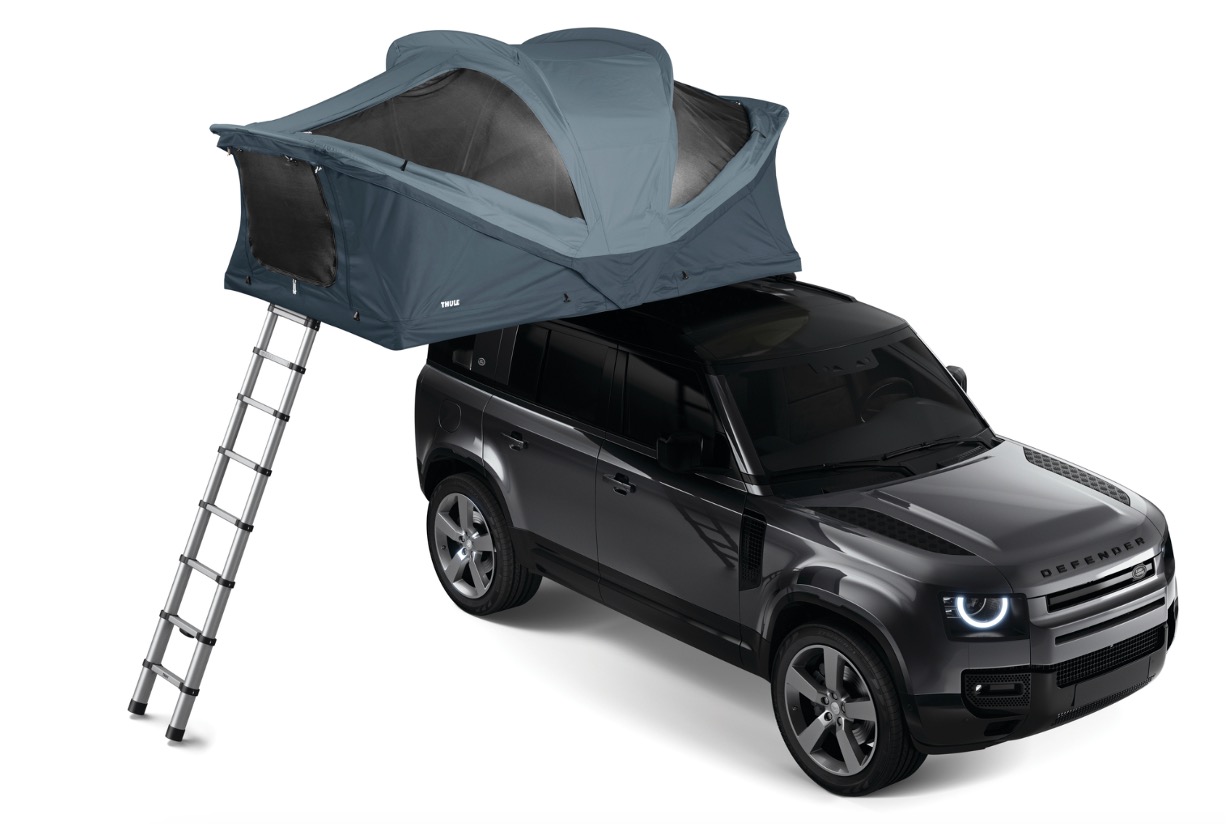
(Photo courtesy of Thule)
Specifications
Type:
Soft shell
Sleeps:
2-3
Stowed footprint:
143 x 124 x 28cm
Weight:
58kg
Price:
£2,499.99
Features:
Panoramic skylights, removable rain cover, mosquito screens, dual-layer foam mattress, quick-release lockable mounting brackets, choice of colours
Available from:
T: 01143 493550
E: [email protected]
W: thejourneycentre.co.uk
RoofBunk Roamer
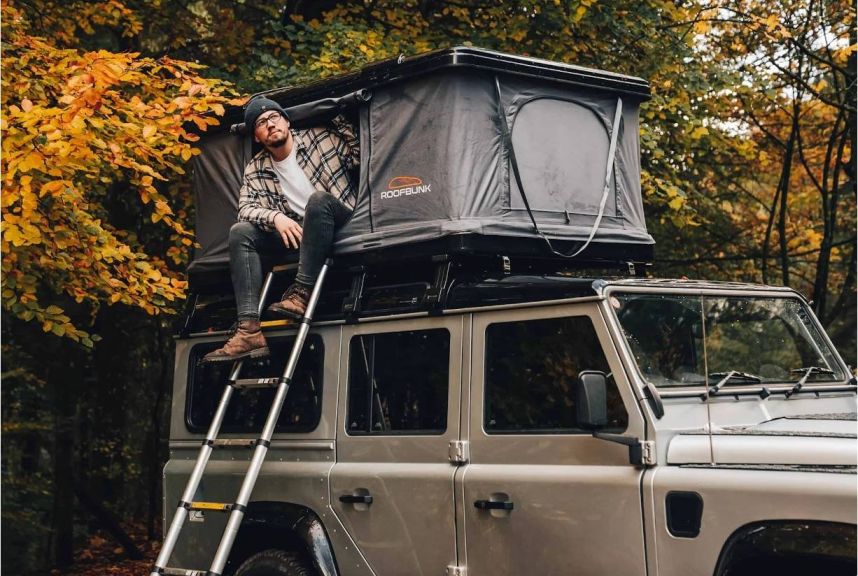
(Photo courtesy of RoofBunk)
Specifications
Type:
Hard shell
Sleeps:
2-3
Stowed footprint:
210 x 140 x 27cm
Weight:
65kg
Price:
£1,749
Features:
Streamlined shell, stainless-steel gas struts, removable telescopic ladder, two access doors, 7cm foam mattress, interior storage net, fitting kit
Available from:
T: 07940 900614
E: contact @ roofbunk . com
W: roofbunk.com
Femkes Alu Khosi
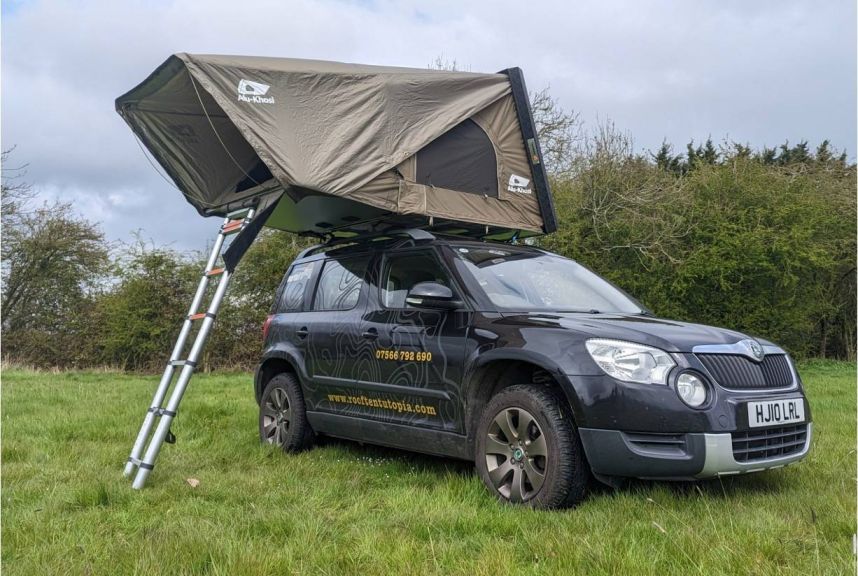
(Picture by Iain Duff
Specifications
Type:
Hybrid
Sleeps:
2
Stowed footprint:
159 x 125 x 27cm
Weight:
68kg inc ladder
Price:
£3,399
Features:
2mm aluminium shell, integrated roof bars, anti-condensation mattress, three storage bags, additional awning canopy, flysheet, anti-theft bolts, telescopic aluminium ladder, two-year warranty
Available from:
T: 07566 792690
E: [email protected]
W: rooftentutopia.com
Terrafirma Expedition TF1710
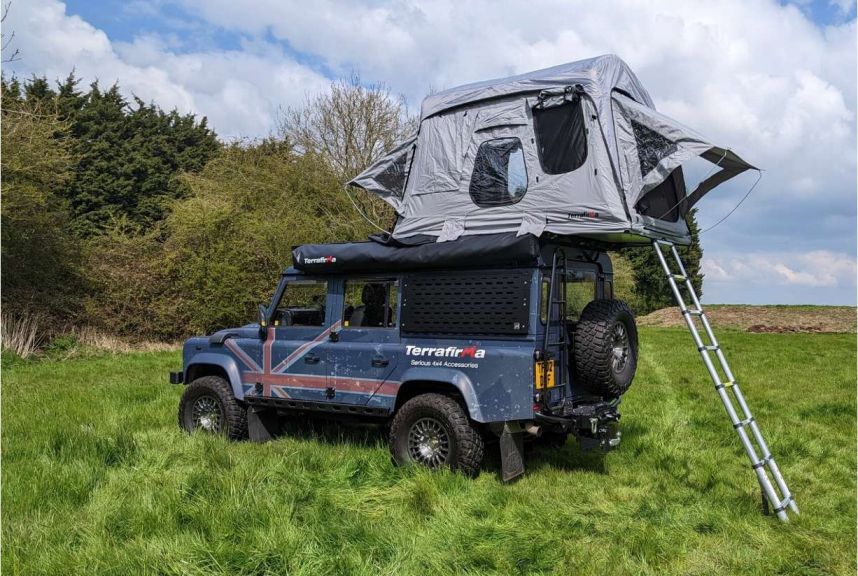
(Picture by Iain Duff)
Specifications
Type:
Inflatable
Sleeps:
2
Stowed footprint:
150 x 80 x 26cm
Weight:
62kg
Price:
£1,669.99
Features:
Small roof footprint, 90mm inflatable tubes, inflatable mattress, PVC windows, high-performance pump, 2.3mm extendable ladder, vinyl cover, mounting kit included
Available from:
T: 01427 753394
E: [email protected]
W: maltings4x4store.co.uk
Tips for using a roof tent
Once your roof tent is installed, you're ready to hit the road. Here are some tips for using it:
- Practise setting up and taking down the tent before you leave on your camping trip. This will help you get familiar with the process and ensure that you're comfortable with the tent's features.
- Be sure to check weather conditions before you set up the tent. High winds or heavy rain can make setting up the tent more difficult or even dangerous.
- When parking your vehicle with the roof tent, choose a level surface that's free of obstacles. This will make it easier to set up the tent and ensure a comfortable sleeping experience.
- Be mindful of weight distribution when packing for your camping trip. It's important to evenly distribute weight throughout the vehicle to ensure safe driving conditions.
- A popular method of storage is hanging the tent from the roof of a garage or car port with ratchet straps, which allows it to be lifted and lowered on and off of the vehicle easily.
Roof tents to hire
If you love the idea of a roof tent but aren’t sure if you want to take the plunge just yet, why not hire one for a holiday and see what they offer before you buy?
ElectricExplorers , based in the Lake District, has roof tents to hire that can be fitted to your own car.
Essential Guide To Camping 2023

Camping - The Essential Guide 2023 is packed with all the information you need to find the perfect tent for you and your family.
We know that buying a new tent is not easy, whether you are a first-time camper or a veteran. But in the Essential Guide we have the answers to all the big questions. Should you go for a tunnel, a dome or a vis-a-vis? Inflatable, pop-up or traditional poles? And is a four-berth really big enough for your family?
#1 Digital edition
Download it now from Pocketmags for just £3.99.
Our digital partner:

Expert Camping advice!

Camping magazine has been the voice of campers for over 60 years!
Camping is the UK's only magazine devoted to the wonderful world of life under canvas and the freedom it brings.
Every issue is packed with inspirational travel, the top camping sites to stay on, reviews of the latest tents, camping gear reviews, practical help and much more to help you get the most out of your camping adventures.
Want to know more about Camping magazine?
About Camping magazine







Recent Updates
Camping barbecue: our guide to cooking up a storm this summer
Is there anything more British than sausages grilled on an open flame and dropped on wet grass? Camping and barbecues go hand in hand, which is why ...
Our family camping checklist: everything you need to pack
Sure, you’ve packed the tent and the sleeping bags – but what about slip-on shoes and glow sticks? These are ...
Our guide to planning the perfect camping road trip
Roll down the window, pop on those shades and crank up the volume – it’s time for a road trip. Get ready for ...
Camping in Europe: our 12 top tips
If you’ve not camped in Europe before, there’s a few tips and tricks you’ll need to avoid some continental ...
Solar power for camping: all you need to know
Staying connected in the great outdoors is easier than ever with a solar charger – or is it? How reliable are ...
Wild camping kit list: everything you need for your next adventure
Make sure you’re ready for anything with this list of lightweight camping gear and clothing, including ...
Camping furniture: all you need to know to make your tent a cosy haven
We delve into the essentials of camping chairs, camping tables, and kitchen and bedroom furniture, ensuring ...
Camping lights for tents: What you need to know
We will guide you through all the lighting options available for you and your tent, including interior ...
Camping kitchen: all you need to know
In the great outdoors, a well-equipped camping kitchen transforms mealtime into a delightful adventure ...
How to pack away your camping gear for winter
A complete guide to packing and storing your gear at the end of the season ...
Other Articles
Camping guide to trailers
Trailer stash or trailer trash? Being able to carry lots of other gear when you go camping isn’t such a bad idea, is it? Nick Harding looks at the ...
Winter camping: all you need to know to keep warm
Winter doesn’t have to mean the end of the camping season. With good preparation and the right gear, there’s ...
Camping toilets: a complete guide
If you are wild camping, camping off-grid or the campsite you book onto doesn’t have toilet facilities, you ...
Top tips for camping in windy weather
How to make sure your tent stands up to gusty conditions ...
Camping tents: a complete guide
If you're considering buying a camping tent, whether it's your first time or you're a seasoned camper, making ...
Camping sleeping bags and beds: a complete guide
When it comes to camping, there's one essential item that can make or break your outdoor adventure: the ...
Camping gas: how to use gas on the campsite
A complete guide to using camping gas appliances safely on the campsite, from choosing the right stove to ...
Camping storage: a complete guide
Having problems knowing where to put all your gear when you're camping? Read our top tips and see some great ...
Camping electric hook-up: a complete guide
This is everything you need to know about using electricity on a campsite, including how to hook up ...
How to pack all your camping gear into your car
Planning a family camping holiday? Find out the best way to fit all the kit you need into your car boot, roof ...